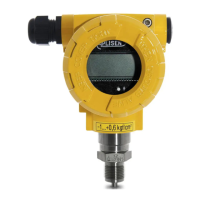E6 53 DTR.APC.APR.ALW.03(ENG)
11. INSPECTIONS AND SPARE PARTS
11.1. Periodic service
Periodic inspections should be made in accordance with the regulations to which the user is subject. During
inspection, the pressure connectors should be checked for loose connections and leaks, the electrical
connectors should be checked with regard to tightness and the state of the gaskets, cable glands, and the
diaphragm seals should be checked for tarnishing and corrosion.
Check the characteristic conversion curve by following the procedures for “Calibration” and, where appropriate,
“Configuration”.
11.2. Other services
If the transmitters are installed in a location where they may be exposed to mechanical damage, excess
pressure, hydraulic impulses or excess voltage, or the diaphragm may be in danger from sedimentation,
crystallization or erosion, inspections should be carried out as required.
Where it is found that the signal in the transmission line is absent or its value is incorrect, a check should
be made on the line and its terminal connections.
Check whether the values of the supply voltage and load resistance are correct.
If a communicator is connected to the power supply line of the transmitter, a fault in the line may be
indicated by the message “No response” or “Check connection”.
If the line is in order, check the operation of the transmitter.
11.3. Cleaning the Diaphragm Seal, Overloading Damage
11.3.1. Sediment and dirt which have formed on the diaphragm in the course of operation must not be removed
by mechanical means, as this may damage both the diaphragm and the transmitter itself.
The only permitted method is the dissolving of sediment.
11.3.2. Sometimes transmitters malfunction due to damage caused by overloading, e.g. in case of:
- Application of excessive pressure;
- Freezing or solidification of the medium;
- Action of a hard object, such as a screwdriver, on the diaphragm.
Usually in such cases the symptoms are such that the output current falls below 4mA or rises above 20mA,
and the transmitter fails to respond to input pressure.
11.4. Spare parts
Parts of the transmitter which may be subject to wear or damage and require replacement: cover gasket.
Other listed parts, due to the specific features and requirements of explosion-protected devices,
may be replaced only by the manufacturer or by a firm authorized by the manufacturer.
12. PACKING, STORAGE AND TRANSPORT
The transmitters should be packed singly or in sets, in such a way as to protect them from damage during
transportation.
The transmitters should be stored in multiple packs under cover, in a place free of vapours and reactive
substances, with temperature and humidity not exceed the limits specified in p. 5.2.2 for APC… or p. 5.3.3 and
5.4.2 for APR….
Transmitters with uncovered diaphragm or seal connectors, stored without packaging, should have covers to
prevent damage to the diaphragm.
During transportation, the transmitters should be packed and secured so as to prevent them from shifting.
Any means of transport may be used, provided direct atmospheric effects are eliminated.
13. GUARANTEE
The manufacturer reserves the right to make constructional and technological changes which do not lower the
quality of the transmitters
14. SCRAPPING, DISPOSAL
Waste or damaged transmitters should be dismantled and disposed of in accordance with Directive
(2012/19/EC) on waste electrical and electronic equipment (WEEE) or returned to the manufacturer.

